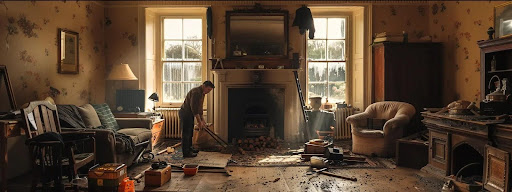Finding the right chimney cleaning service is essential for maintaining your home’s safety, efficiency, and longevity. A well-maintained chimney ensures your fireplace works optimally and helps prevent damage, structural hazards, and health risks like carbon monoxide poisoning. In this guide, I share my experience as a chimney sweep business owner, offering advice on finding reputable local professionals in the United Kingdom, what to expect during cleaning, signs that your chimney needs attention, and factors that affect cleaning costs. Whether you use a wood-burning, multifuel, or gas appliance, proper chimney care is vital for home safety, energy efficiency, and even preventing roof repairs caused by excessive heat or smoke.
Find Local Chimney Sweeps in Your Area
Finding reliable chimney cleaners starts with an online search or word-of-mouth recommendations. Try searching “chimney cleaners in my area” with regional terms like “London” or “Wales.” Local providers offer faster response times, personalized service, and a strong understanding of local building styles, fuel types (coal, wood, smokeless fuel), and regulations that impact cleaning techniques and inspections.

Searching for Chimney Cleaning Services Close By
When you search “chimney sweepers in my area,” quality companies appear at the top of search results and local listings. Check Google Business, Trustpilot, and local directories for customer reviews which provide insights into service quality and reliability. Always verify that the cleaners are properly licensed and insured to ensure adherence to industry safety standards.
Benefits of Choosing a Nearby Chimney Sweep
Local chimney sweep services offer flexibility in scheduling and quicker appointments—crucial during peak seasons or emergencies. They are familiar with local building codes and weather conditions that can affect soot or creosote build-up. Additionally, they often have good relationships with local suppliers, potentially lowering costs, and can provide on-the-spot minor repairs or thorough post-cleaning inspections.
How to Locate Reputable Chimney Cleaners Nearby
Use specific keywords like “local chimney cleaners,” “chimney sweep near me,” or “chimney cleaning United Kingdom.” Combine online research with recommendations from friends, neighbours, or social media groups. Reputable companies typically have detailed websites outlining services—from routine sweeps and flue lining repairs to carbon monoxide detector testing—and clearly state their service areas, which may include towns like Pontefract, Doncaster, and Wakefield.
Verifying Credentials of Local Chimney Professionals
Before hiring, check that the chimney sweep belongs to recognized industry groups like the Guild of Master Chimney Sweeps. They should provide proof of insurance, certifications in chimney safety, and service guarantees. These credentials demonstrate a commitment to high standards and protect you from risks such as carbon monoxide poisoning or costly roof repairs due to poor service.
Comparing Quotes From Chimney Services in Proximity
Obtain multiple quotes to balance cost and quality. Each estimate should detail services offered—including removal of soot, creosote, bird nests, and debris, along with post-cleaning inspections. Compare these quotes carefully to spot hidden fees or overly low prices that might signal substandard work. Some providers offer package deals that combine cleaning with repairs like flue lining replacement.
Understand the Chimney Cleaning Process
Professional chimney cleaning involves several steps to ensure your chimney is safe and operating efficiently. The main goals are to remove harmful soot and creosote, ensure all components like the chimney liner and flue are intact, and prevent future hazards.

What to Expect During a Professional Chimney Clean
A cleaning appointment begins with an on-site inspection to assess the chimney’s condition and safety. Technicians use specialized brushes, vacuums, and extendable rods to clean out soot, creosote, and debris such as bird nests. The process may include testing the draft and measuring creosote levels to determine needed action. A thorough cleaning restores optimal combustion in your fireplace or stove and reduces fire risks.
Standard Procedures for Chimney Sweeping
Standard cleaning involves sealing off the work area to control dust, then brushing the chimney with extendable rods. Debris is dislodged and vacuumed out. Some services include a camera inspection to ensure the chimney liner is undamaged and the flue is clear. These procedures are essential in preventing fire hazards and maintaining good indoor air quality.
Advanced Techniques in Chimney Maintenance
Some professionals use advanced techniques like video inspections, high-powered vacuums, and air compressors for a deeper clean. These methods can reveal micro-cracks or partial blockages otherwise unseen. In addition, treatments such as flue blocking solutions and soot inhibitors may be applied to slow down future creosote build-up, especially in homes using coal, wood, or multifuel systems.
Duration of a Typical Chimney Cleaning Appointment
Most chimney cleaning appointments last one to two hours, though more complex chimneys with multiple flues or inconsistent maintenance histories may require more time. The goal is to ensure every part of the chimney is thoroughly cleaned and inspected to avoid future repairs, such as roof damage from falling debris.
Post-Cleaning Inspection and Report
After cleaning, technicians perform a detailed inspection to verify that no residues remain and that the chimney liner and flue are intact and sealed. They provide a comprehensive report documenting the work done and any recommendations for further maintenance. This report is useful for insurance claims and offers peace of mind regarding the overall safety of your home.
Recognise Signs Your Chimney Needs Cleaning
A clean chimney is critical for safe and efficient home heating. However, homeowners may miss signs that indicate the need for cleaning. Recognizing these signs early helps avoid hazards.
1
Telltale Indicators of a Dirty Chimney
Visible soot or creosote accumulation around the fireplace or flue is a clear sign your chimney needs cleaning. Black stains on walls or an overly dirty chimney cap indicate dangerous build-up that can lead to fires or carbon monoxide leaks. A sudden drop in fireplace efficiency is another alert.
2
Odours Signalling a Need for Chimney Sweeping
Unpleasant, musty, or burning odours coming from the chimney suggest excessive creosote and soot build-up. Such smells may also indicate poor ventilation or inefficient combustion conditions, which increase the risk of hazardous gas accumulation.
3
Poor Fireplace Performance as a Symptom
If your fireplace is not generating as much heat or shows inconsistent flame behavior, blockages from soot and creosote might be causing reduced airflow. This compromised draft can also lead to smoke back-drafting into your home.
4
Animal Nests and Debris in Your Chimney
The presence of bird or squirrel nests, or signs of animal activity like chewed insulation, clearly indicates that your chimney is blocked and must be cleaned promptly. These blockages not only reduce efficiency but also heighten fire risks.
5
Soot Build-Up Around the Fireplace Opening
Excessive soot build-up around the fireplace or on inner chimney walls serves as a warning that cleaning is overdue. Regular maintenance helps avoid even more severe issues, such as flue blockages and potential fire hazards.
Advantages of Regular Chimney Maintenance Nearby
Regular maintenance protects your home by keeping the chimney clean and safe. Frequent inspections and cleanings not only extend the lifetime of your chimney but also help avoid costly repairs and insurance issues.

Improved Home Safety With Clean Chimneys
A clean chimney minimizes the risk of damaging chimney fires and carbon monoxide poisoning, as harmful creosote and soot are regularly removed. Early detection of structural issues means repairs can be done before emergencies arise.
Enhanced Efficiency of Your Fireplace or Stove
Routine cleaning ensures your fireplace or stove operates more efficiently, reducing fuel consumption whether you use wood, coal, or other solid fuels. This results in better heat output and a more consistent draft.
Prevention of Costly Chimney Repairs
Regular inspections catch small issues like minor cracks or early creosote build-up before they evolve into larger problems. Preventive maintenance is a cost-effective approach to avoid emergency repairs and safeguard your home’s structure and roof.
Better Air Quality Within Your Home
By removing accumulated soot and debris, a clean chimney improves indoor air quality. Cleaner combustion means fewer pollutants enter your living spaces, reducing respiratory risks and creating a healthier home environment.
Meeting Home Insurance Policy Requirements
Many insurance policies require proof of regular chimney maintenance. Keeping clear records and inspection reports can prevent denied claims and may even lower your premiums by reducing the risk of significant damage from chimney fires
Selecting the Right Chimney Cleaning Service Near You
Choosing the right chimney cleaning service is crucial for safety and effectiveness. With many local providers to choose from, careful research and specific questions can help you make the best decision.
1
Questions to Ask Potential Chimney Sweeps
Before hiring, ask about years of experience, membership in professional groups like the Guild of Master Chimney Sweeps, available service guarantees, inspection methods, and warranties offered. Inquire about pricing breakdowns, the estimated time for cleaning, and whether they offer additional repair services like chimney cap installation or flue lining repairs.
2
Checking Online Reviews for Local Cleaners
Online reviews on platforms like Google and Trustpilot provide insights into reliability and service quality. Positive feedback on prompt service, thorough cleaning, and fair pricing is key, while patterns of negative reviews or hidden fees are red flags.
3
Importance of Insurance and Certification
Always choose a chimney cleaner who is fully insured and certified by recognized industry bodies. This ensures that the technicians are properly trained and that both your home and the service provider are protected in the event of accidents.
4
Understanding Service Agreements and Guarantees
Carefully review the service agreement before committing. The document should outline all steps of the cleaning process, include any inspection or follow-up services, and specify service guarantees or warranties. Clear agreements protect you from unexpected costs and ensure reliable service.
5
Finding Specialists for Your Chimney Type
Different chimneys require different expertise. Whether your system is wood-burning, gas, multifuel, or uses solid fuel, select a specialist with experience working on your specific type. This ensures proper use of tools and techniques, leading to optimal performance and longevity.
Chimney Cleaning Frequency Recommendations
The frequency of chimney cleaning depends on usage, fuel type, and environmental factors. Regular maintenance is essential to keep your chimney operating safely and efficiently.

How Often Should You Have Your Chimney Cleaned
Experts typically recommend at least one cleaning per year, especially before the heating season. Increased soot buildup, reduced draft quality, or performance issues may call for an additional cleaning during colder months. Homes using solid fuels like wood or coal may require more frequent maintenance compared to those with gas appliances.
Factors Influencing Cleaning Schedules
Factors include the type and quantity of fuel burned, with wet or green wood producing more creosote. Environmental influences such as wind-driven rain or dust, and the age and design of your chimney, also determine cleaning needs. Tailor your maintenance schedule according to these variables.
Guidelines for Different Fuel Types
Wood-burning appliances usually need annual or even biannual cleaning due to higher creosote production, while gas fireplaces produce less residue but still benefit from regular inspections. Multifuel systems may require customized schedules to address the unique properties of each fuel used.
Seasonal Considerations for Chimney Sweeping
During winter, when your fireplace or stove is used more frequently, a thorough cleaning is essential before the cold season begins. In summer, when usage is lower, schedule inspections and minor repairs to keep the system in top condition, particularly after long periods of inactivity.
Advice From Local Fire Safety Officials
Local fire safety officials and building inspectors strongly recommend adhering to annual cleaning schedules, with additional inspections if any malfunctions are detected. Their guidance helps ensure compliance with safety standards and provides extra peace of mind regarding your home’s fire safety.
Cost of Chimney Cleaning Services in Your Vicinity
Chimney cleaning costs vary by location, service type, and job complexity. Understanding these factors allows you to budget effectively and select a provider who offers good value for money.
1
Average Prices for Chimney Sweeping Locally
In the United Kingdom, standard chimney cleaning typically costs between £80 and £150, though prices may be higher in larger cities like London or regions with higher operating expenses. Some companies offer discounts or package deals when additional services such as flue inspections or minor repairs are included.
2
What Influences the Cost of Chimney Cleaning
Cost factors include the cleaning method (manual versus advanced techniques), fuel type, chimney height and complexity, and any extra maintenance required (for example, addressing bird nests or repairing a damaged liner). Regional variations and the provider’s reputation also affect pricing, as does the inclusion of follow-up inspections in some quotes.
3
Obtaining Accurate Estimates From Nearby Providers
Request detailed written quotes that list all related fees—labor, materials, inspections, and any extra charges for unforeseen complications. Free in-home consultations can also help determine a precise estimate, ensuring transparency and helping you avoid hidden fees.
4
Value of Professional Cleaning Versus DIY Risks
Although DIY cleaning might seem cost-saving, improper cleaning can lead to high expenses from repairs due to soot-induced corrosion or accidental fires. Professional chimney cleaners bring expertise and specialized equipment, and they provide detailed maintenance reports that can benefit your home insurance. This investment enhances long-term safety and saves money over time.
5
Spotting Hidden Fees in Chimney Cleaning Quotes
Always clarify whether quotes include potential hidden fees, such as for hazardous material disposal, extended travel, or additional time required for deep creosote removal. A comprehensive quote helps ensure you know exactly what you’re paying for without surprises.
Preparing Your Home for a Chimney Sweep Visit
A smooth, efficient chimney cleaning requires some preparation at home. Taking simple steps beforehand can protect your belongings, make the technician’s work easier, and prevent disruptions.

Steps to Take Before the Chimney Cleaner Arrives
Clear the immediate area around the fireplace and chimney of furniture, decorations, and personal belongings. Inform family members so that pets and children are kept safe and away from the work area. Having previous maintenance records on hand can also help the professional understand your chimney’s history.
Clearing the Area Around Your Fireplace
Ensure that the space around your fireplace is clutter-free by removing loose items, rugs, and ornaments. A clear workspace allows the chimney sweep to work quickly and thoroughly, reducing the risk of soot spreading to your belongings.
Protecting Furniture and Belongings From Soot
Cover nearby furniture and floors with disposable cloths or plastic sheeting to protect them from soot and dust generated during cleaning. These precautions make cleanup easier and help maintain your home’s neat appearance.
Ensuring Access for the Chimney Sweep
Provide clear access to all parts of the chimney by unlocking any necessary doors or gates and removing obstacles. This ensures the technician can complete their inspection and cleaning without interruption.
Securing Pets During the Cleaning Process
Keep pets in a quiet room or have someone look after them during the appointment. This prevents them from interfering with the work and reduces their stress in an unfamiliar environment.
Chimney Safety Inspections by Local Experts
Regular safety inspections by local experts are key to maintaining your chimney’s condition. These inspections assess structural integrity, detect hazardous deposits, and spot potential fire risks early.
The Role of Safety Inspections in Chimney Care
Safety inspections review venting systems, chimney liners, and overall construction to identify damage, blockages, or carbon monoxide risks. Detailed inspection reports help you stay informed and provide documentation for home insurance.
Different Levels of Chimney Inspection Explained
Inspections range from basic visual checks to comprehensive evaluations using video equipment. Basic inspections cover readily accessible areas, whereas a Level 2 inspection uses cameras to examine hidden parts. Each level ensures potential hazards are identified and addressed before they develop into major issues.
When to Schedule a Professional Chimney Inspection
It is best to schedule an inspection once a year, ideally before the heating season starts. If you notice decreased efficiency, unusual odours, or excessive soot, arrange an immediate inspection. Follow-up inspections are also advisable after repairs or modifications.
Identifying Potential Hazards Through Inspection
Technicians look for creosote build-up, cracks in the liner, debris blockages, water damage, and corrosion. Early detection of these hazards allows for timely repairs that keep your chimney safe and effective.
Reports and Recommendations Following an Inspection
After an inspection, a detailed report is provided that outlines the chimney’s condition and recommends any necessary maintenance or repairs. Keeping these reports helps with ongoing maintenance and is beneficial when selling your home.
Additional Services Offered by Chimney Cleaners Near Me
Many chimney service providers offer additional services beyond basic cleaning to maintain and upgrade heating systems, ensuring safety and efficiency.

Chimney Repair Services Available Locally
Local providers often repair small cracks in the chimney liner, replace damaged mortar, or fix broken chimney caps. Prompt repairs can prevent minor issues from becoming costly problems, including water leakage or structural damage.
Installation of Chimney Caps and Cowls
Installing chimney caps and cowls prevents water intrusion, bird nests, and debris accumulation. These components enhance the longevity and performance of your chimney by improving the draft and reducing maintenance needs.
Bird and Pest Guard Fitting
Specialized bird and pest guards help prevent nests and blockages by keeping out intruders without affecting airflow. This service improves chimney efficiency and reduces health risks related to pests.
Carbon Monoxide Detector Testing and Installation
Chimney professionals may test and install carbon monoxide detectors to provide early warnings of dangerous gas build-up. This service is especially important for homes with gas-powered appliances or enclosed fireplaces.
Flue Lining Repairs and Replacement
Repairing or replacing the flue lining protects the chimney walls from corrosive by-products of combustion. Using modern materials and techniques, experts extend your chimney’s life, enhance heating performance, and reduce risks of heat loss and leaks.
Frequently Asked Questions
It is recommended to clean your chimney annually, especially before the heating season. Homes that burn wood or coal may require additional cleanings, while gas appliances generally need at least an annual inspection to prevent dangerous build-ups.
Look for visible soot, creosote accumulation, unpleasant odours, poor fireplace performance, and signs of animal nests or debris. These indicators suggest that cleaning is overdue and necessary to maintain efficiency and safety.
Compare detailed estimates that include all aspects of the service—soot and creosote removal, debris clearing, inspections, and any extra charges. Check customer reviews and verify the inclusion of insurance and warranties to ensure you choose a reliable provider.
Beyond cleaning, many providers also offer repairs, chimney cap installation, pest guard fitting, carbon monoxide detector testing, and flue lining repairs or replacement to keep your chimney structurally sound and efficient.
Credentials such as membership in the Guild of Master Chimney Sweeps, proper certification, and insurance verify that the technician is trained and committed to maintaining high safety standards, reducing the risk of accidents and subpar workmanship.
Many insurance policies require proof of regular maintenance. Keeping inspection reports and maintenance records can prevent denied claims and may lower your premiums by demonstrating proactive safety measures.
Clear the area around your fireplace, move furniture and decorations, cover valuables with disposable cloths, and secure pets. Ensure clear access for the technician by unlocking doors and removing obstacles, enabling a smooth and efficient cleaning process.
Final Thoughts
Chimney cleaning is crucial for a safe, efficient heating system and a healthy home. Regular professional maintenance prevents dangerous build-ups of soot and creosote, avoids costly repairs, and helps maintain good indoor air quality. By choosing a reputable local service with transparent pricing and the right certifications, you safeguard your home against fire hazards and ensure long-term efficiency.
